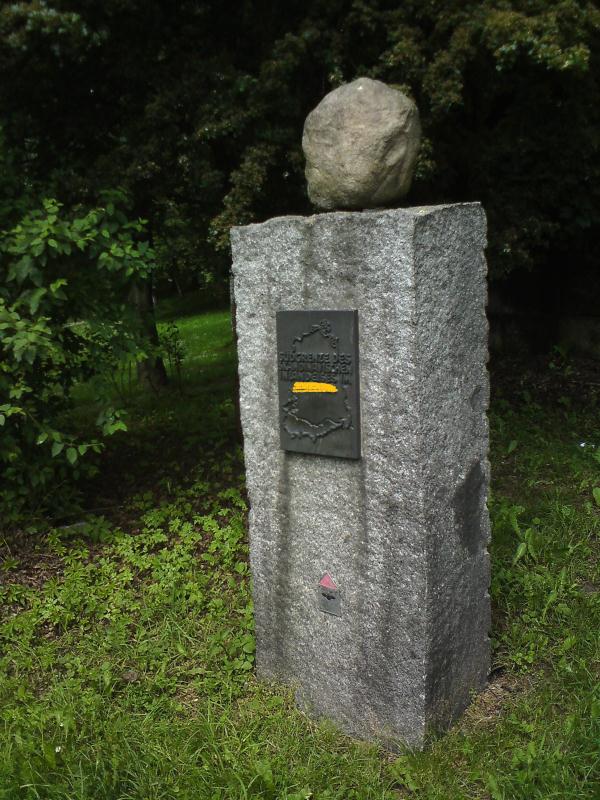Am Bromacker bei
Tambach-Dietharz in Thüringen ist die bedeutendste Fundstätte für
primitive Landwirbeltiere aus der Zeit des Perm außerhalb der USA
freigelegt worden. Der Bromacker liegt im Tambacher Becken im
Thüringer Wald. Die hier bisher gefundenen Wirbeltiere stammen aus
zwei jeweils etwa einen Meter dicken Tonschichten innerhalb der
Sandsteinbänke der Tambach-Formation (Rotliegend). Dieser
rötlich-braune gleichkörnige Feinsandstein mit
Schrägschichtungskörpern teilt die Ton-Siltlagen in mehrere Bänke.
Die Fundstätte wurde 1974 vom deutschen Paläontologen Dr. Thomas
Martens gefunden. Seitdem graben im Bromacker deutsche und
amerikanische Paläontologen zusammen nach Fossilien. Bisher wurden
neben etlichen Insekten- und Pflanzenversteinerungen über 40
Skelette von rund 12 Ur-Reptilienarten ans Tageslicht befördert.
Das derzeitige Grabungsgebiet erstreckt sich über 300 Quadratmeter,
Probebohrungen haben aber ergeben, dass die eigentliche Größe 1-2
Hektar betragen kann.

Die Sedimente vom Bromacker wurden auf einer
Hochebene durch kleine Flüsse abgelagert. Das damalige Klima war
saisonal und bestand aus einer Regen- und einer Trockenzeit, wie in
einer heutigen Savanne. Die für diese Zeit typischen Fossilfunde
wie Fische und Amphibien fehlen. Stattdessen wurden überwiegend
große, pflanzenfressende Tiere gefunden. Aquatische Arten fehlen
völlig. Bisherige Funde: Tambachia, ein Trematosaurier, Seymouria,
die namensgebende Gattung der Seymouriamorpha, der Diadectomorphe
Orobates, der nur auf den Hinterbeinen laufende Bolosauride
Eudibamus, Thuringothyris, ein Vertreter der Captorhinida, der
große fleischfressende Pelycosaurier Dimetrodon, sowie drei bisher
unbeschriebene Gattungen, ein kleiner Vertreter der Dissorophoidea,
ein Caseide und ein Varanopseide. An den Koordinaten sind etliche
umfangreiche Sandsteinplatten mit Fährten und Skeletten
verschiedener primitiver Landwirbeltiere aus der Gruppe der
Temnospondylen, von Vorfahren der Reptilien und von Peycosauriern,
die bei den Ausgrabungen freigelegt und später präpariert wurden,
zu finden. Hinweistafeln an den Sandsteinplatten erläutern die
Herkunft, das Alter und ihre Fundorte.

Nun zum Cache:
Um diesen Cache loggen zu können, erfülle bzw. löse folgende
Aufgaben und sende mir Deine Antworten über meine
Profil-email-Adresse:
1. Bitte macht ein Foto von Euch oder Eurem GPS vor der Säule
"Südgrenze des skandinavischen Inlandeises im xxxxxxx" und hängt
dieses Foto Eurem Log an.
2. In welchem Zeitalter war hier die Grenze des skandinavischen
Inlandeises?
3. Wieviel Zentimeter hat der Durchmesser der skizzirten
Umrisskarte auf der Vorderseite dieser Säule (von unten nach oben
gemessen)?
4. Zu welchen Tieren ist man hier besonders freundlich?
Du brauchst nicht auf meine Logfreigabe zu warten und kannst direkt
nach Deiner Antwortmail loggen. Bei grossen Abweichungen melde ich
mich bei Dir. Aber bitte vergiss das Foto vor der Säule
nicht.
Nun viel Spaß beim Tüfteln und Ermitteln.
English
description
From Ice-ages and dinosaurs
In the bromine field
at Tambach-Dietharz in Thuringia the most significant place of
discovery has been exposed for primitive land vertebrates from the
time of Perm beyond the USA. The bromine field lies in the
Tambach-valley in the Thuringian wood. This reddish-brown, fine
sandstone with sloping stratification bodies divides the slips-silt
levels into several benches. The place of discovery was found in
1974 by the German paleontologist Dr. Thomas Martens. Since then
German and American paleontologists dig in the bromine field
together for fossils.

Up to now more than 40 skeletons were found
beside several insect fossilization and plant fossilization by
about 12 old reptile's kinds. The present excavation area applies
more than 300 square meters however, test drillings have proved
that the real size can amount to 1-2 hectares. The sediments of the
bromine field were deposited on a plateau by small rivers. The
climate at that time was seasonal and existed of a rainy season and
a drying time, how in a today's savanna. The fossil founds typical
for that time like fish and amphibians are absent. Instead, big,
plants-eating animals were found predominantly. Aquatic kinds are
completely absent. Present founds: Tambachia, a Trematosaurier,
Seymouria, the name-giving type of the Seymouriamorpha, the
Diadectomorphe Orobates, the Bolosauride Eudibamus only running on
the hind legs, Thuringothyris, a representative of the
Captorhinida, the big meat-eating Pelycosaurier Dimetrodon, as well
as three types blank up to now, a small representative of the
Dissorophoidea, a Caseide and a Varanopseide. At the coordinates
you can find several extensive slaps with tracks and skeletons of
different primitive land vertebrates from the group of the
Temnospondylen, from forefathers of the reptiles and from
Peycosauriern which were exposed with the excavations and were
preserved later. Infoboards at the slaps explain the origin, the
age and her finding places.

Now to the Cache
To be able to log this Cache, answer the following questions and
send an email to my profil-email-address. You do not need to wait
for my permission and can login directly to your e-mail reply. If
there are differences with your answers, I will be with you, the
answers can be found locally.
1. Please take a photo of you or your GPS in front of the pilar
"Südgrenze des skandinavischen Inlandeises im xxxxxxx" and attach
this Picture to your log.
2. In which age here was the border of the scandinavian inland
ice?
3. How much centimeters has the diameter of the outlined map at the
front of this column (take your measurement from below
upwards)?
4. To which animals is one especially friendly here?
However, please do not forget the photo in front the column.
And now have much fun.